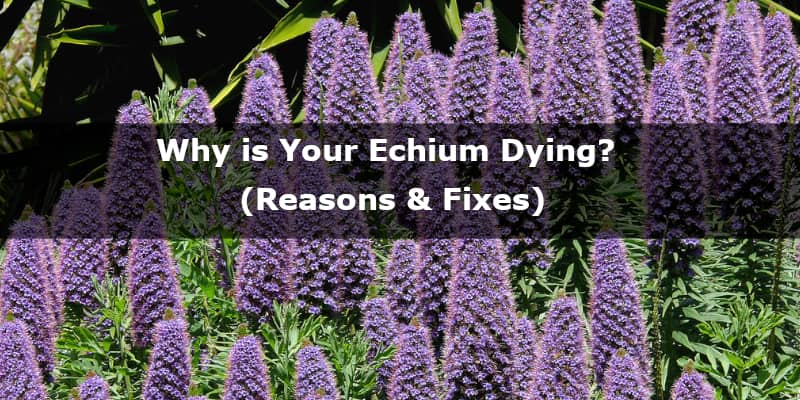Does your echium look like it’s dying?
Don’t worry, as an experienced gardener, I know what’s going on with this plant.
Why is Your Echium Dying?
The most common reason why echium is dying is its life cycle, as the plant lives only 2 years. Other reasons include strong wind, inadequate watering, or frost.
There aren’t lots of reasons why echium might be dying, as the plant is pest resistant, and takes care of itself alone most of the time.
So, it might be dying, because it stopped its life cycle, or the wind could blow it over. Also, you might have overwatered it, it’s planted in poor soil, or it’s affected by frost.
Get to know all the reasons behind a dying echium, identify them, and learn what you can do about it!
Natural Life Cycle
Echium belongs to the biennials, which means that its life cycle lasts only 2 years. In the first year, the plant undergoes primary growth, and in the second year, it’s fruiting, and then dies.
So, if it’s exactly the second year, and the plant stopped flowering, and it kneels over, you can be sure that your echium died, and there’s nothing you can do about it.
After the flowers are spent, hundreds of tiny seeds release to the ground below. In spring, you should see many volunteer plants, starting the whole biennial cycle over anew.
If the plant is dead, all you can do is cut it down and pull it out.
Note: Some echium varieties can live up to 4 years, but it’s a rare case.
Wind Rock
Echium lifespan is only 2 years. Because of that, the plant doesn’t have enough time to develop strong, and deep roots. Echium’s roots are indeed very shallow.
It depends on the variety, but some echium cultivars can grow up to 15 feet (450 cm) tall. However, in most cases, echium isn’t bigger than 6 feet (180 cm) and broader than 3 feet (90 cm).
If you consider shallow roots and the relatively big size of the plant, it means that strong wind gusts might easily blow over your echium. It’s actually pretty common.
Many gardeners recommend keeping echium sheltered from the wind. Even moderately strong wind can blow over this plant.
So, if the plant is showing signs of wind damage, becomes loose, and starts wilting, it will require firming at the base of the stem. This can be achieved by using the heel of your boot carefully, making sure not to damage the main stem. Then, you can stake up the echium.
Inadequate Watering
Inadequate watering can also be a problem. In the case of echium, underwatering isn’t a problem, because the plant is drought-resistant. However, overwatering might be problematic.
Established echium takes care of itself. Thus, it doesn’t need to be watered often. If you tend to water the soil every day, or a couple of times per week, then it’s definitely too much. Ideally, the soil should be slightly moist, but not soggy. You should water it no more than once a week, or once per 2 weeks.
If you water more frequently, the plant will show signs like a yellow or brown limp, droopy leaves, mushy or unstable base, and brown spots or edges encircled by a yellow halo.
In mild cases, you can simply stop watering for the next few weeks and wait for your plant to recover. If the plant is overwatered seriously, repot it and trim away all the affected roots to keep it alive. Healthy root systems are bright white or yellow, while waterlogged roots are black or brown.
Lack of Fertilization
Generally, echium doesn’t need fertilization. However, if it’s planted in very poor soil, you will need to feed the plant with the right nutrients.
If you see the plant has yellow leaves, no new growth, small, pale flowers, and falling leaves, that means that you need to provide it with some nitrogen, phosphorus, and potassium.
This fertilizer on Amazon is the most recommended one for echium.
Frost
Echium is native to the baking climes of the Mediterranean and North Africa. Thus, it loves heat, but can’t withstand low temperatures.
If the temperature in your area dropped to 23 °F (-5 °C), the frost could kill your plant. The signs of frost include wilted growth, and brown leaves that eventually become crispy.
If the stems and roots are in a good shape, you can revive the plant by pruning dead parts of your echium to allow new growth.
Conclusion
Some plants are dying because hundreds of reasons, but echium is really hard to kill, and only 5 factors can kill it.
To grow a healthy echium, provide 6-8 hours of sunlight per day, don’t water it too frequently, and fertilize it if needed. You should also provide a stake, and protection from severe frost, and the plant will grow just fine.
Remember that it will die after 2 years, but it should self-sow in the next year.
Sources
en.wikipedia.org, gardeningknowhow.com, bloomscape.com, plantcaretoday.com

